|
In the 17th and 18th century the English and Dutch were important seafaring and trading nations who on their voyages brought the Far Eastern tea from their oversees colonies to England and Holland.
Thanks to its shared border with the Netherlands, the tea also soon arrived in Ostfriesland. It was expensive when first introduced, and only the upper crust, well-to-do town dwellers and prosperous farmers, could afford this luxury.
Pastors were quick to recognize the benefits of its enjoyment and recommended its use in their congregations as a way of counteracting the abuse of alcohol.
It wasn't long before a luxury beverage for the well situated became a greatly appreciated refreshment for every East Friesian. One important reason for its growing popularity was the fact that it made the water used for brewing more palatable, particularly for those living in the alluvial areas along the coast and rivers and even more so for those in the peat bog regions.
It is said that the blessings of the French revolution, which in the beginning of the 19th century became known by the slogan LIBERTE, egalite, fraternite, were interpreted in Ostfriesland as LIEBER TEE (Rather Tea).
The outcome of these circumstances amazes one to this day:
In Germany the annual per-capita consumption of tea is 172 grams.
In Ostfriesland, however, the average consumption amounts to a strong 6 pounds per person per year.
That is seventeen times the amount the average German consumes!
East Friesland - Tea Land
As the above mentioned consumption data make clear, this designation is well deserved.
There is a dictum valid for all of Ostfriesland that nobody can deny:
"Ostfriesische Gemütlichkeit hält stets ein Tässchen Tee bereit."
(Good times in old East Friesian Land call for a cup of tea on hand!)
Of great importance in all this, naturally, is the tea set used for preparing and serving this beverage. Only the finest porcelain for pot and cups will permit the highest enjoyment of the tea. The design itself is not necessarily important, but the tea service with the "East Friesian Rose" enjoys great popularity in the entire region and may be found in many, if not all, households.
The Ostfriesen tea itself is a blend of various varieties from the famous tea growing regions Assam, Darjeeling, and Ceylon.
There are in Ostfriesland famous blenders of tea, such as Buenting, Thiele, Onno Behrends, etc., some of whom have already offered their blends for more than a century. But small firms, too, founded by entrepreneurs, like the "Teegefällig" label, offer blends which are deeply loved by their customers who (almost) never change brands, though common to them all is that sought-after tart, hearty flavor that no East Friesian will do without.
The Preparation of Tea
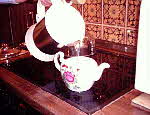 The teapot is rinsed with hot water (prewarmed). The teapot is rinsed with hot water (prewarmed).
Per cup of its total volume, a moderately heaping teaspoon of Ostfriesen tea is placed in the pot (not a coffee spoon; it is too large, and the tea would become undrinkable).
Boiling water is poured over the tealeaves until they are completely covered with water.
- On a warming plate or over a tabletop heating flame, the tea is allowed to steep for 3 minutes (stimulating effect) or 5 minutes (calming effect).
- Now more of the boiling water is poured into the pot until full.
- A "Kluntje" (rock candy) is placed in each cup.
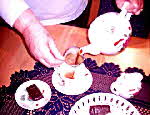 Carefully the tea is poured over the sugar until the cup is about half full while one enjoys the crackling sound of the bursting sugar crystals. Carefully the tea is poured over the sugar until the cup is about half full while one enjoys the crackling sound of the bursting sugar crystals.
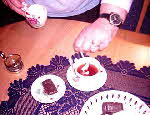 With a skimming spoon a bit of cream is carefully "placed" on the surface of the tea. The cream sinks into the tea and then rises again to the surface like a "Wulkje" (a little white cloud). With a skimming spoon a bit of cream is carefully "placed" on the surface of the tea. The cream sinks into the tea and then rises again to the surface like a "Wulkje" (a little white cloud).
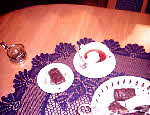 The tea is not stirred. One enjoys its varying taste levels from the somewhat tart first sip to the sweetness at the bottom of the cup. The tea is not stirred. One enjoys its varying taste levels from the somewhat tart first sip to the sweetness at the bottom of the cup.
- When the cup is empty, the host will refill it unless the guest places the teaspoon in the empty cup -
That is the sign he or she does not want any more.
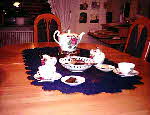 It is said: Three are East Friesian right. It is said: Three are East Friesian right.
So one drinks at least 3 cups.
|